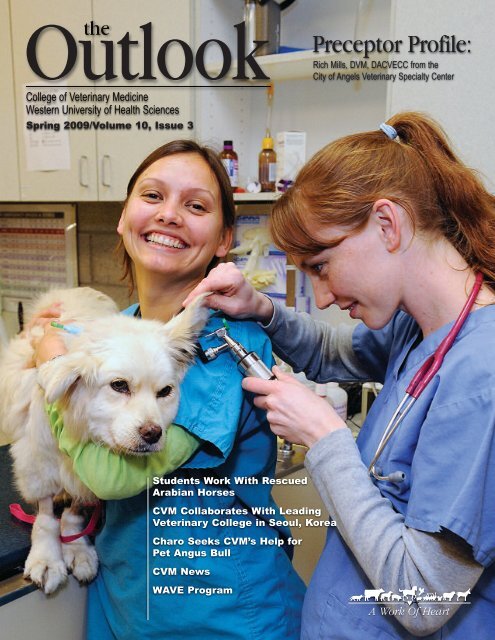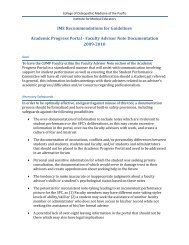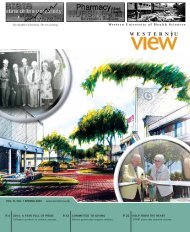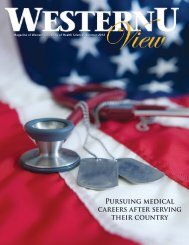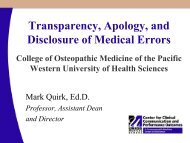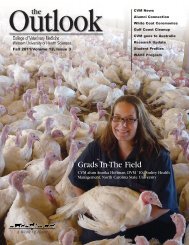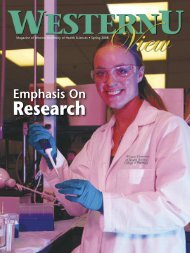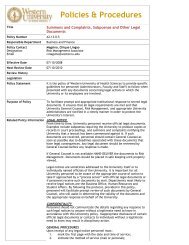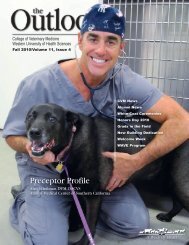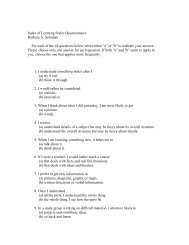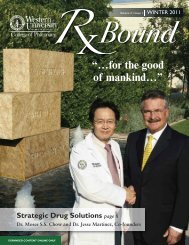Outlook Preceptor Profile: - Western University of Health Sciences
Outlook Preceptor Profile: - Western University of Health Sciences
Outlook Preceptor Profile: - Western University of Health Sciences
You also want an ePaper? Increase the reach of your titles
YUMPU automatically turns print PDFs into web optimized ePapers that Google loves.
<strong>Outlook</strong>theCollege <strong>of</strong> Veterinary Medicine<strong>Western</strong> <strong>University</strong> <strong>of</strong> <strong>Health</strong> <strong>Sciences</strong>Spring 2009/Volume 10, Issue 3<strong>Preceptor</strong> <strong>Pr<strong>of</strong>ile</strong>:Rich Mills, DVM, DACVECC from theCity <strong>of</strong> Angels Veterinary Specialty CenterStudents Work With RescuedArabian HorsesCVM Collaborates With LeadingVeterinary College in Seoul, KoreaCharo Seeks CVM’s Help forPet Angus BullCVM NewsWAVE Program♥A Work Of Heart
W o r d f r o m t h e D e a nI recently heard a colleague invoke the beginning sentence<strong>of</strong> A Tale <strong>of</strong> Two Cities by Charles Dickens to describe thepresent economic climate: “It was the best <strong>of</strong> times, it wasthe worst <strong>of</strong> times…”The College has undergone unprecedented growth in staffand faculty during the past fiscal year, fully occupied thenew Banfield Veterinary Clinical Center, and expects tocomplete the Veterinary Pathology Center before this fiscalyear ends. At this very moment construction <strong>of</strong> newbuildings totaling approximately $75 million is underway inpreparation <strong>of</strong> the opening <strong>of</strong> four new medical colleges inthe fall and providing an additional 6,000 sq. ft. <strong>of</strong> researchspace. While the status <strong>of</strong> our state, national and globaleconomies dictate a cautious outlook and prudent planning– our microeconomic environment appears to be booming!The <strong>University</strong> is presently developing a unique interpr<strong>of</strong>essional curriculum that willprovide an interactive environment for students from all nine medical colleges. The goal isfor <strong>Western</strong>U graduates to demonstrate an understanding <strong>of</strong> other health pr<strong>of</strong>essions and toprovide and promote a team approach to patient care and health care management, leadingto improved patient care.The veterinary pr<strong>of</strong>ession has long claimed to be a part <strong>of</strong> the public health care team.However, the “One Medicine – One <strong>Health</strong>” concept as promoted by the AVMA does notmatch the actual public perception <strong>of</strong> veterinary medicine. There is no better illustration <strong>of</strong>the chasm between the veterinary pr<strong>of</strong>ession’s view and the public’s view <strong>of</strong> the role <strong>of</strong>veterinarians in health care, than the recent California proposal to tax veterinary services aspart <strong>of</strong> a budgetary response to astounding state deficits.Clearly, our state – indeed, our nation has significant financial problems to address. It is notthe tax proposal itself that I want to discuss. It is the framework <strong>of</strong> the debate that I foundillustrative.While defending the tax proposal, a spokesperson for the California Finance Departmentnoted that the proposed tax also would extend to auto and appliance repair, golf fees,sporting events and amusement parks such as Disneyland and Knott’s Berry Farm.I am sure that we all would agree that it would be a stretch to include human medicalservices in this disparate group <strong>of</strong> business activities. My dismay lies in the possibility thatthe defense provided seems to suggest that the inclusion <strong>of</strong> veterinary medical services isnot an oddity. More to the point, it seems to suggest that the contribution <strong>of</strong> veterinaryservices to the public health may be valued (at least by some) as little as a golf game, or asporting event.It is up to us to dispel this misperception. As a member <strong>of</strong> the <strong>Outlook</strong> family, I encourageyou to do what you can. We have a lot <strong>of</strong> work before us!♥the<strong>Outlook</strong>Spring 2009/Volume 10, Issue 3College <strong>of</strong> Veterinary Medicine<strong>Western</strong> <strong>University</strong><strong>of</strong> <strong>Health</strong> <strong>Sciences</strong>Associate Editor:Paul Gordon-Ross909.706.3529pgordon@westernu.eduAssociate Editor:Leigh Wiemannlwiemann@verizon.netContributor:Renee Cook909.469.5651rcook@westernu.eduPhotographer:Jess Lopatynski909.469.5298jlopatynski@westernu.eduGraphic Designer:Paul Gettler909.469.5256pgettler@westernu.edu------309 E. Second St.Pomona, CA91766-1854www.westernu.edu/cvm♥A Work Of HeartO n T h e C o v e rCVM students from the class <strong>of</strong> 2010; Christina Portus, left andChristina Kane, right with patient at the City <strong>of</strong> AngelsVeterinary Specialty Center in Culver City, CA.Photo by Jess LopatynskiIt is the best <strong>of</strong> times; it is the worst <strong>of</strong> times…Phillip Nelson, DVM, PhD2
Rare Arabian Herd Rescued, Rehabilitated,Ready to Work as Equine TherapistsWESTERN UNIVERSITY OF HEALTH SCIENCES DVM students beginclinical skills training in the first year <strong>of</strong> their program, practicingphysical exams and wellness care in the College’s two wellnessclinics. Second-year students gain more experience in theVeterinary Ambulatory Community Service vehicle, a clinic-onwheelsthatprovidesfree/low-costservices topeople whocan’t affordveterinarycare. Largeanimalclinicalexperience takes place at California State Polytechnic <strong>University</strong>,Pomona, at community preceptor practice sites, and during themany occasions when students volunteer with CVM faculty tohelp nonpr<strong>of</strong>it organizations like The Pegasus Rising Project(www.pegasusrising.org) and its rescued herd <strong>of</strong> at-risk Arabianhorses.In January, eleven CVM students (some from the Student Chapter<strong>of</strong> the American Association for Equine Practitioners), and facultyvolunteers Dr. Paul Gordon-Ross and Dr. Elizabeth Schilling,joined volunteer equine veterinarians Dr. Steven Colburn andDr. Jeffrey Moss <strong>of</strong> Creekside Veterinary Service(www.creeksidevets.net) in Escondido, CA to help with physicalexams, surgical castrations, and ho<strong>of</strong> trimmings for a rescuedArabian herd <strong>of</strong> nine stallions,17 mares and three foals.For Tiffany Stillian, DVM ’11,the experience was nothingless than amazing. “For thefirst horse, Drs. Colburn andMoss demonstrated a fullequine castration, fromanesthesia induction, to theactual castration, to recovery.After this demonstration, wedivided into groups, where weeach got a chance atadministering injectable sedation and anesthesia, injectableantibiotics, preparing the surgical site, and actually performing halfor full castrations under doctor supervision and direction.”The family <strong>of</strong> horses rescued by Pegasus Rising is no ordinaryherd. The two original horses were brought from Poland with thehelp <strong>of</strong> Ronald Reagan during his Presidency. The first <strong>of</strong> thesetwo stallions—champion racer Gedymin—won races in Polandequivalent to the U.S.Triple Crown,while Dalimin was a descendent<strong>of</strong> the great stallion Lotnik,imported by World War IIGeneral George S. Patton.The 29 <strong>of</strong>fspring <strong>of</strong> thesetwo rare, historicallysignificant Arabianchampions had developedand lived together over 30years on a ranch thatdegenerated as the ownersaged. They weremalnourished, teeming withparasites, up to their ankles inmud and their own waste.“This is about rescuing a very significantgroup <strong>of</strong> horses that are innately different than a lot <strong>of</strong> horses weencounter.They’re extremely docile and loving toward humans,”explained Cynthia Royal, founder <strong>of</strong> the Pegasus Rising Project.Julie Huber, DVM ’12, hasn’t decided if she will pursue equinemedicine, but she does plan to own a horse, and welcomed theopportunity to gain hands-on experience. “My favorite part <strong>of</strong> theday was taking part in an exam on a horse that had a history <strong>of</strong>chronic obstructive pulmonary disease,” she said. “Dr. Colburnwalked us through the signs that the horse was displaying, allowedus to auscult the thoracic cavity, and educated us on the adverseeffects <strong>of</strong> performing anesthesia on a patient in this condition.”Dr. Elizabeth Schilling noted,“The students got to see some <strong>of</strong> thecommon complications associated with these ‘routine’ procedures,such as colic, had an opportunity to discuss the complications, andthink about strategies to prevent them rather than deal withthem.”When they regain their health, these gentle horses will have a newmission: to teach people with trust issues, past abuse or any type<strong>of</strong> emotional trauma how to safely relate and connect withanother living creature again. The “Healing with Horses Therapyand Enrichment Programs” will provide equine-assistedpsychotherapy to further the emotional healing <strong>of</strong> veterans withpost-traumatic stress disorder, abused children, autistic children,and survivors <strong>of</strong> domestic violence.“The goal is to raise human healing, potential and consciousness toa new level through the way <strong>of</strong> the horse,” explains Cynthia Royal.“The Pegasus Rising Project will <strong>of</strong>fer opportunities for all torealize a clearer understanding <strong>of</strong> the role that horses and humansplay in healing each other, the community and the planet.”4
College and Seoul National <strong>University</strong> CVM toCollaborate on Research, Clinical ProgramSEOUL NATIONAL UNIVERSITY (SNU), a prestigious public researchuniversity founded in 1946 and located in Seoul, Korea, is ranked50th in the world and 8th in Asia by U.S. News & World Report,and 24th in the world in publications by the Science CitationIndex. The <strong>University</strong> comprises 16 colleges, six pr<strong>of</strong>essionalschools, a student body <strong>of</strong> about 30,000 and is considered themost competitive university in South Korea. SNU graduatesdominate South Korea's academics, government, politics andbusiness.“The College <strong>of</strong> Veterinary Medicine, Seoul National <strong>University</strong>, hastaken a significant step forward with the collaborative link wehave established with the College <strong>of</strong> Veterinary Medicine at<strong>Western</strong>U, which has a group <strong>of</strong> world class clinical faculty,” saidDr. Park.The MOU between the two institutions is expected to help fosteracademic exchange through collaborative research, teaching andclinical projects.The College <strong>of</strong> Veterinary Medicine at SNU conducts world-leadingresearch in the areas <strong>of</strong> stem cells, avian influenza, and otherzoonotic diseases including Bovine Spongiform Encephalopathy(BSE). <strong>Western</strong> <strong>University</strong>’s College <strong>of</strong> Veterinary Medicine hasclinical faculty such as Dr. Y. Lyon Lee, DVM, PhD, diplomate <strong>of</strong>the American College <strong>of</strong> Veterinary Anesthesiologists and a nativeKorean, who are internationally known with the board specialistrecognition that SNU lacks. Dr. Lee is a 1989 graduate <strong>of</strong> SeoulNational <strong>University</strong>.Yong-Ho Park, DVM, PhD, Dean <strong>of</strong> the College <strong>of</strong> VeterinaryMedicine at SNU, is committed to promoting global education andresearch collaboration with partners at institutions in the UnitedStates, Japan, China,Vietnam and other countries.Dr. Park and Dr. Phillip Nelson, Dean <strong>of</strong> the College <strong>of</strong> VeterinaryMedicine at <strong>Western</strong> <strong>University</strong> <strong>of</strong> <strong>Health</strong> <strong>Sciences</strong>, recently signeda Memorandum <strong>of</strong> Understanding (MOU), establishing a newrelationship <strong>of</strong> creative cooperation and collaboration with anemphasis on research.<strong>Western</strong>U’s Pacific Rim collaboration with its new partner in Koreawill <strong>of</strong>fer opportunities for SNU to learn about the U.S. veterinaryschool’s excellent clinical education, which SNU seeks to adopt.Dr. Park has set a goal for the College <strong>of</strong> Veterinary Medicine atSNU to achieve a position among the world’s top 20 veterinarycolleges by the year 2020. This new partnership will also <strong>of</strong>fer<strong>Western</strong>U’s College <strong>of</strong> Veterinary Medicine opportunities tobenefit from SNU’s excellent track record <strong>of</strong> graduate training andresearch.“The new synergy between our two veterinary colleges will moveboth <strong>of</strong> our programs into stronger academic and researchpositions,” said Dr. Nelson. “We are honored and look forward tomany years <strong>of</strong> creative cooperation with the College <strong>of</strong> VeterinaryMedicine at Seoul National <strong>University</strong>.”“Grads in the Field” continued from page 2I have practiced general medicine and surgery in a small animal clinic in Chula Vista, CA since August 2008. Iabsolutely love my job and I am grateful for having found this practice to become a part <strong>of</strong>. I finished a one-yearinternship at the Southern California Veterinary Specialty Hospital (formerly Southern California Veterinary ReferralGroup) after graduating. From the training I received there and from the two years <strong>of</strong> clinical rotations at <strong>Western</strong>U, Ihave felt completely prepared for all <strong>of</strong> the cases I have seen. Sure, there are plenty <strong>of</strong> things that I see or do for thefirst time, but there is never a shortage <strong>of</strong> resources within reach that give me the answers I need. I work with asupportive crew and I have an endless supply <strong>of</strong> friends, classmates, and colleagues to call with questions I may have.I still use VIN almost everyday, which I was introduced to at <strong>Western</strong>U, and the library <strong>of</strong> textbooks I have collected forthe <strong>Western</strong>U curriculum surrounds me at work. It is a rewarding job and I am thankful to have chosen veterinary medicine as a career.Michelle Schexneider, DVMPacific Pet Hospital, Chula Vista, CACharter Class <strong>of</strong> 2007Grads: Have you had a scientific paper published in a peer-reviewed journal? Please let us know!Contact Renee Cook at rcook@westernu.edu. Thanks!5
PRECEPTOR PROFILEBy Rich Mills, DVM, DACVECCI GREW UP ON A SMALL FARM IN RURAL CUMBERLAND, R.I. We hadchickens, ducks, turkey, cow, pig, rabbits. My family was veryinterested in animals, which spawned my interest.When I wasin college I decided to become a veterinarian. My BS in animalscience is from the <strong>University</strong> <strong>of</strong> Rhode Island, and DVM fromAuburn <strong>University</strong>. My initial interest was in dairy medicine, butduring veterinary school I decided to do small animalemergency and critical care. I interned at Denver VeterinarySpecialists, and did my residency at The Animal EmergencyCenter in Glendale,Wis.The biggest impact on my career was Dr. Dougie Macintire, aboarded diplomate in internal medicine and emergency andcritical care. She helped me get my first preceptorship (11week rotation in emergency and critical care (ECC)) withanother mentor, Dr. Jennifer Devey. From that point on I washooked and loved emergency medicine. I loved surgery andmedicine and the specialty <strong>of</strong> ECC allowed me to do both. Ialso love the craziness <strong>of</strong> emergency and the variety <strong>of</strong> caseswe see.Advanced Critical Care Los Angeles is a “partner practice” at theCity <strong>of</strong> Angels Veterinary Specialty Center (COAVSC) located inthe City <strong>of</strong> Angels Veterinary Specialty Center, a 24-hourveterinary specialty center, in Culver City, Calif. We <strong>of</strong>ferspecialists in emergency and critical care, surgery, internalmedicine, and cardiology. We also have a residency inemergency critical care with three residents at this time.There are multiple different specialty groups within ourbuilding, such as Eye Care for Animals, Southern CaliforniaVeterinary Imaging,The Dog and Cat Dentist, and VeterinaryCancer Group. Specialists include four oncologists, a radiationoncologist, one full time and one half time ophthalmologist,two part time dermatologists, a dentist, and a radiologist.Advanced Critical Care (ACC) currently employs 59 staffmembers including seven board certified/board eligibledoctors cardiologist, three veterinary emergency and criticalcare residents, and one emergency doctor. Our center is thelargest in Los Angeles County, the only complete veterinaryspecialty center in Los Angeles, and unique in that it has almostevery advanced technology available to pet owners, includingspiral CT, Linear Accelerator, a nuclear medicine department forI131, and all nuclear studies, ERG, operating microscope,phacoemusification, digital radiography, ultrasound, and digitaldental imaging.ACC is also the only practice in L.A. with dialysis, fluoroscopywith vascular package for full angiography and embolizationtherapies, Lithotripsy and an interventional service. We <strong>of</strong>ferfull minimally invasive services (thoracoscpoic, laproscopic,arthroscopic) and provide the only urethra stenting, trachealstenting and urological laser surgery in L.A.We provide ventilation therapy,full in house laboratory, fullendoscopy services (cystoscopy,urethroscopy, ureteroscopy,upper GI endoscopy and LowerGI endoscopy.) We are the onlypractice in Los Angelesperforming urethral collagentherapy for incontinence. Ourpractice is one <strong>of</strong> only three centers in the country to placedynamic occluder devices for urinary incontinence, and theonly hospital in California to perform chemoembolization andbland embolization therapy for cancer patients. Our surgerydepartment provides the most complex surgeries in veterinarymedicine, including free microvascular grafts and limb spare.Our hospital is based on the most current therapies availableand focuses on teaching.<strong>Western</strong>U CVM students come in early, do PE’s on their inhouse patient and look over the record.We have cage siderounds with all the doctors where students are asked questionsabout physiology and pathophysiology as well as differentials.We talk about everything from the drugs we use to thetreatment plans.Through the day, students look up answers tothe questions, which we talk about at evening rounds or thenext morning. Students write soaps on at least one patient aday, and help with histories and PE’s.We talk about eachanimal, developing a problem list, differential list, diagnosticplan, therapeutic plan, and monitoring plan.I tell students that if something does not make sense, repeatthe test or go back to a good history and physical exam, wherethings are missed due to insufficient oral and rectalexamination. I encourage them to have balance in their lives, totake a step back and have away time. Balance promoteslongevity in life and work! Lastly…always do the best thing forthe owner and patient. Practice good, ethical medicine andeverything will be alright.Our hospital has had a wonderful experience with students atour practice. The excitement <strong>of</strong> students seeing a case cometogether in their heads is wonderful. I am always excited aboutveterinary medicine, and when we have students who lovewhat they are learning it creates a wonderful atmosphere.Seeing and doing things that could not be done previously inveterinary medicine is absolutely amazing. The students arereally an important part <strong>of</strong> getting the word out and being atthe forefront <strong>of</strong> knowledge.The thing I enjoy most is the excitement <strong>of</strong> learning. Kind <strong>of</strong>geeky, but this is what it is all about. The greatest challenge isdoing cases, management and teaching residents and students.So much we want to do, but not enough time.6
Students Win Trip to Nation’s Capitalin Diversity Essay ContestTEAMWORK IS A CREATIVE DANCE. The team must work towardagreement on a solution to a problem, but must avoid the trap<strong>of</strong> “groupthink”—faulty decision making that minimizesconflict to reach consensus without critically testing, analyzing,and evaluating ideas.More than 10 years <strong>of</strong> research in organizational behaviorindicates that in culturally diverse teams, members create moreideas, alternatives, and potential problem solutions than inteams with less diversity.Veterinarians work in one <strong>of</strong> the most diverse healthpr<strong>of</strong>essions. From public health veterinarians protecting ourfood supply to family pet caregivers, a variety <strong>of</strong> careeropportunities awaits those earning a DVM degree. However, wedo not find a comparable diversity when we look at thepopulation <strong>of</strong> veterinary pr<strong>of</strong>essionals and students in theUnited States, which reflect a lack <strong>of</strong> diversity that poses aproblem to the veterinary pr<strong>of</strong>ession and to society. But isdiversity within the veterinary pr<strong>of</strong>ession really that important?Kayla Corriveau, DVM ’12, a firstyear veterinary student, agrees that itis, and entered the College’s fallsemester diversity essay contest forfirst and second year students.She wrote:“One <strong>of</strong> the most important parts <strong>of</strong>individual diversity is that eachperson will be shaped by theirbackground and thus have uniqueviews and opinions on issues thatarise. My choice to attend <strong>Western</strong>Uwas based on the idea that I wouldKayla Corriveau, DVM, ’12 learn a lot more in a PBL [problembased learning] setting where eachindividual has an opportunity to learn from and debate withtheir peers. During my time at <strong>Western</strong>U, I have seen thatdiversity is a valuable asset to the learning process. Debatesover differing viewpoints are responsible for medical advances,corrections to erroneous theories, and memorable learningexperiences. If everyone involved in the medical pr<strong>of</strong>essionhad the same thoughts and opinions, change would never bepossible since there would be no chance for debate orconflicting viewpoints. Diversity is imperative to the veterinarypr<strong>of</strong>ession so that it can progress and advance.”<strong>Western</strong>U’s College <strong>of</strong> Veterinary Medicine is committed toadmitting a diversified class <strong>of</strong> students that better reflect thepopulation <strong>of</strong> the United States and California, and has takenmeasures to enhance student diversity. The College isresponding to national concerns throughout the veterinarypr<strong>of</strong>ession as a whole.Every other year, the AmericanAssociation <strong>of</strong> VeterinaryMedical Colleges (AAVMC) inWashington, D.C. hosts the“Iverson Bell Symposium”during the Association’snational meeting. The oldestforum related to diversity inveterinary medicine, theSymposium is dedicated toDr. Iverson Bell, an AfricanAmerican veterinarian andtwo term vice president <strong>of</strong> theAmerican Veterinary MedicalAssociation, who worked topromote diversity within theveterinary pr<strong>of</strong>ession. The17th Symposium was heldMarch 12-13.“During my timeat <strong>Western</strong>U, Ihave seen thatdiversity is avaluable assetto the learningprocess.”--Kayla Corriveau, DVM ’12The College’s diversity essaycontest was the inspiration <strong>of</strong>Assistant Pr<strong>of</strong>essor SuzanaTkalcic, DVM, PhD, who received her DVM from the <strong>University</strong><strong>of</strong> Zagreb in Croatia (Europe.) Two winning essays wereselected and the students—Kayla Corriveau, and ElisabethMulvany, DVM ’12, also a first yearstudent—won a trip to Washington,D.C. to attend this year’s Iverson BellSymposium. Elisabeth Mulvany wassurely looking with hope toward thefuture when she wrote the followingexcerpt from her essay:“Because veterinary medicine, likehuman medicine, requires years <strong>of</strong>work and preparation, it is moreimportant to instill a love <strong>of</strong> thesciences early in children from lowersocioeconomic classes andElisabeth Mulvany DVM, ’12 disadvantaged backgrounds. Thismeans having outreach programsaimed at inspiring curiosity and exposing children to thewonders <strong>of</strong> science early. If these children have the necessaryfoundation for a career in science, then they are primed forrecruiting efforts which may be aimed at undergrad students.Because a lack <strong>of</strong> diversity leads to stagnation this is a veryimportant issue to be addressed in the interest <strong>of</strong> continuedcareer growth. A stronger, more capable and diverse theapplicant pool for vet schools means a stronger more capableand more diverse population <strong>of</strong> veterinarians after graduation.”7
C V M S t u d e n t P r o f i l e s - C l a s s o f 2 0 1 2♥Samantha AbairI was born on an Air Force base in Upperhayford,England, raised in Santa Cruz, California, andspend my time hunting and camping with my dadin northern Idaho. I have a BS in animal sciencefrom California Polytechnic State <strong>University</strong>, SanLuis Obispo. I am interested in large animalmedicine and equine surgery.Stephanie BrownI am from Ohio and moved to Arizona 18years ago. I received a BS in agribusiness fromArizona State <strong>University</strong>, then an MS inpathobiology from <strong>University</strong> <strong>of</strong> Arizona.I was a veterinary technician for ten years andspent a year at a diagnostic laboratory. I’minterested in small animal medicine.Raised in Tijuana, Mexico, I moved to the U.S.after finishing high school and graduated fromSan Diego State <strong>University</strong> with a BS in biology.I have a great passion for exotic animals,especially birds and reptiles. I am currentlyinterested in practicing with exotic animals orsmall animal surgery.Aleli CamachoI was born and raised in Pasadena, California,and majored in economics and molecularand cell biology at <strong>University</strong> <strong>of</strong> California,Berkeley. I explored a finance career,worked at a veterinary hospital, thendecided veterinary medicine was definitelythe way to go. I am so very excited to beginmy graduate studies at <strong>Western</strong>U.Susan ChaoHaley HartzheimRaised in Pendleton Oregon, I completed aBS in zoology at Oregon State <strong>University</strong>.My work experience includes a small animalprivate practice, a research laboratory andmost recently the <strong>University</strong> <strong>of</strong> California,Davis Veterinary Medical Teaching Hospitaloncology department. I am ecstatic to jointhe “elite” group <strong>of</strong> veterinary students.Stephanie HengstBorn and raised in Thousand Oaks,California, I received a BS in biology fromCalifornia Lutheran <strong>University</strong>. I was aworking student at a horse ranch for fouryears, and worked for an exotic practiceveterinarian for two years. I decided I wasgoing to be a vet at the age <strong>of</strong> 5 and havepursued it since.I received my BS in marine fisheries from TexasA&M <strong>University</strong> (2004) and MS in aquaticbiology from Texas State <strong>University</strong> (2007).Whilecompleting my master’s degree, I was employedby the Texas Parks and Wildlife Fish <strong>Health</strong> &Genetics Laboratory. I enjoy international travel,SCUBA diving, and geocaching.Erin O’DochartyBorn in Escondido, California, I graduatedwith a BS in agriculture/animal science fromNew Mexico State <strong>University</strong>. I have workedin the veterinary field since 2000 and loved itfrom the beginning! I enjoy concerts,cooking, and other fun things. I am thankfulfor this opportunity and can’t wait to start!S<strong>of</strong>ia PadillaVincent PatanioI was born and raised in Brooklyn, New Yorkand graduated with a BS in pre-veterinaryscience from <strong>University</strong> <strong>of</strong> Massachusetts.My pr<strong>of</strong>essional interests include small animalsand exotics, with a major interest in surgery.I am very excited to begin my education at<strong>Western</strong> <strong>University</strong> <strong>of</strong> <strong>Health</strong> <strong>Sciences</strong> andlook forward to beginning my career.Neha PatelBorn and raised in Orange County,California, I graduated with a BS from<strong>University</strong> <strong>of</strong> California, San Diego in2007. I have volunteered at animalshelters and worked as a veterinaryassistant at a clinic, and can’t wait tobegin my veterinary career!8
C V M S t u d e n t P r o f i l e s - C l a s s o f 2 0 1 2♥Born and raised in California’s Central Valley,I graduated from California PolytechnicState <strong>University</strong>, San Luis Obispo with a BSin animal science and minor in poultrymanagement. I have two QueenslandHeelers, Hank and Beta. I’m excited to startschool toward my pursuit <strong>of</strong> becoming asmall animal and exotic bird practitioner.Stevie PerryI am from San Diego, California, and receivedmy BS in physiology and neuroscience from<strong>University</strong> <strong>of</strong> California, San Diego in 2007.I have worked as a registered veterinarytechnician, have eight years <strong>of</strong> veterinaryexperience, and wanted to be a veterinariansince I was a little girl. My interests includesmall animal medicine and public health.Megan PhillipsJuilanne PorterI am from upstate New York, where I livedwith five dogs and two cats on a farm. As aveterinarian, I plan to focus on emergencymedicine and research, and am interested inthe influence domestic animals have on oursociety. I also play the piano.Molly RagusaI grew up in sunny Southern California,and received a BS from <strong>University</strong> <strong>of</strong>California, San Diego. I was a nationallyranked gymnast and a competitivesurfer. My passion for marine mammalsand training horses has led me toveterinary medicine.I was born and raised in Plymouth,Massachusetts, and have a BS inbiology/pre-vet from Roger Williams<strong>University</strong> in Rhode Island. I lookforward to an exciting career inveterinary medicine and hope tobecome board certified in cardiology.Kursten RoderickBorn in Massachusetts and a recentgraduate <strong>of</strong> Northeastern <strong>University</strong> inBoston, I have also lived in various stateson both the east and west coasts.I especially enjoy working with horsesand dogs and gaining unique experiences.After <strong>Western</strong>U, I hope to specialize andeventually open an animal sanctuary.Lindsey RynkKyla SavickA Jacksonville, Florida native, I went fromcheerleader to martial artist to earningbaccalaureate honors in biology (<strong>University</strong> <strong>of</strong>North Florida, 2007), to finally pursuing mylife-long dream <strong>of</strong> becoming a veterinarian! Fornow, I remain a dedicated personal assistant tomy favorite female felines, Safire and Jimmy.Corinne SchotBorn and raised in the San FranciscoBay area, I graduated from San FranciscoState <strong>University</strong> with a BS in physiologyand was married to Mark Anderson inJuly 2008. I am proud cat-mom to“Kitty,” who is 16 years old.Born in Norfolk,Virginia, I grew up inNew York, England and Canada.I received a BS in human kinetics fromthe <strong>University</strong> <strong>of</strong> Guelph, Ontario.Throughout my life, animals have playeda large role, particularly my involvementin equine sports, which has led me topursue a career in equine medicine.Hannah SkottyI was born and raised in Cincinnati,Ohio and have always beensurrounded by animals. I received aBS in zoology from Miami <strong>University</strong>in Ohio in 2008, am very excited tobe pursuing a career in veterinarymedicine, and hope to become alarge animal veterinarian.Laura Smiley9
Using Bioinformatics and ComparativeGenomics to Map Cancer-associatedPhenotypes to the Canine GenomeMY NAME IS GABRIELLE GALGOUL. I am a member <strong>of</strong> the DVM2011 class and currently serve as secretary <strong>of</strong> the ZoologicalWildlife Exotic Conservation Club. Last summer I participatedin the student summer researchfellowship. Under the guidance <strong>of</strong>faculty advisor Kristopher J. L.Irizarry, PhD, assistant pr<strong>of</strong>essor <strong>of</strong>bioinformatics, genetics, and genomicsat the College <strong>of</strong> Veterinary Medicine,I and my classmate, Audrey Hoholm,DVM ’11, conducted research usingbioinformatics and comparativegenomics to map cancer-associatedphenotypes to the canine genome.Using comparative genomic analysis, weGabrielle Galgoul DVM ’11worked to identify “candidate” regions<strong>of</strong> the dog genome that elicit cancer,looked at existing genetic variation in the canine genome, andmade inferences about how much genome variation exists inthese regions. Thus far, in the research project, we haveBLASTed the canine genome to the mouse genome and viceversa to correlate genes that both species share, which areknown as orthologous genes. Using the LINUX operatingsystem, we compiled our data into tables using MYSQL queriesfrom available information from the mouse genome and thecanine genome through the use <strong>of</strong> NCBI database. These tableswill help us further analyze our comparative data to ultimatelyfind orthologs among the genes to allow us to make inferencesabout cancer genes. Documentation <strong>of</strong> the results is underway.I plan on continuing our research this summer, hoping tocomplete it and publish a scientific manuscript.The results <strong>of</strong> this project could potentially assist veterinariansand encourage breeders to produce more genetically soundanimals in hopes <strong>of</strong> eliminating congenital cancers.When I applied to the CVM at <strong>Western</strong>U,I didn’t think I would ever pursueresearch as a field <strong>of</strong> interest, nor did Ithink I would spend two summersparticipating in a student summerresearch fellowship. In addition toworking on research in the summer,Audrey and I, along with Dr. Irizarry andDr. Katherine Mitsouras, assistantpr<strong>of</strong>essor <strong>of</strong> biochemistry at <strong>Western</strong>U’sCollege <strong>of</strong> Osteopathic Medicine <strong>of</strong> thePacific, were invited to present ascientific poster at the AKC Canine<strong>Health</strong> Foundation’s “Genes Dogs andCancer: 5th International Canine Cancer Conference” heldFebruary 13-15, 2009, in Orlando, Florida. Now that I have beenexposed to the exciting field <strong>of</strong> research, I am consideringpursuing the research thesis course during my fourth year as aDVM student. Though I plan to work as a practitioner in smallanimal medicine, I am also very interested in includingresearch as part <strong>of</strong> my pr<strong>of</strong>essional career.More information on genomics research being conducted by<strong>Western</strong>U CVM students may be found at “<strong>Western</strong>UVeterinary Medicine Students Study Genomics” published inthe September/October 2008 issue <strong>of</strong> California Veterinarian, apublication <strong>of</strong> the California Veterinary Medical Association.(Go to http://www.cvma.org/doc.asp?id=20398.)From left to right: Dr. Katherine Mitsouras, Gabrielle Galgoul, DVM ’11,Audrey Hoholm, DVM ’11, and Dr. Kristopher IrizarryFrom left to right: Jae Yoo, DVM ’11, AudreyHoholm, DVM ’11 and Gabrielle Galgoul, DVM ’1110
RESEARCHUpdateMaria Pia Phillips, PhDAssistant Pr<strong>of</strong>essor, Virology& ImmunologyDr. Phillips pursues research invirology—the study <strong>of</strong> virusesand virus-like agents, theirstructure, classification,evolution and reproduction,the diseases they cause, thetechniques to isolate andculture them, and their use inresearch and therapy, as wellas immunology—a broadbranch <strong>of</strong> biomedical sciencethat covers the study <strong>of</strong> allaspects <strong>of</strong> the immune systemin all organisms.It is known that both the drug <strong>of</strong> abuse methamphetamine(METH) and the Human Immunodeficiency virus (HIV), thevirus that causes AIDS, damage the brain. However, theinteractions between HIV and METH that lead to brain damageremain unclear. Gathering data in people is particularlydifficult, given the population that engages in drug abuse, sothere is a need for appropriate animal models.Dr. Phillips is studying the interactions between METH andAIDS that result in brain damage through a FelineImmunodeficiency Virus (FIV)/cat model, developed in thelaboratory, as a system. It is already demonstrated by past workobtained in the laboratory that when both FIV and METH arepresent in cats, a greater disease is produced than when thevirus or the drug are present alone. Dr. Phillips is nowexamining the role <strong>of</strong> Apoptosis (a type <strong>of</strong> cell death) in theFIV-METH induced brain disease in feline CNS cell cultures, todetermine if Apoptosis may explain the virus/drug synergy at amolecular level. She is studying the role <strong>of</strong> Caspases, theproteolytic enzymes that are activated in response to specificsignals and that will start a cascade <strong>of</strong> reactions that will resultin cell death. Dr. Phillips is looking at the extent <strong>of</strong> theiractivation, and also at which specific Caspase is activated.Different caspases are involved in different diseases, and thestudy <strong>of</strong> their activity may provide information about theirpossible role as therapeutic targets.Congratulations to Pr<strong>of</strong>essorVictoria Voith, DVM, PhD, DACVBon the following publication:Victoria L.Voith.The Impact <strong>of</strong>Companion Animal Problems onSociety and the Role <strong>of</strong> Veterinarians.Vet Clin Small Anim 39 (2009)327–345.Congratulations to Assistant Pr<strong>of</strong>essorMiguel Saggese, DVM, MS, PhD, onpublication <strong>of</strong> M. Saggese, I.Tizard,P.Gray and D. Phalen. Oct. 2008.Recent advances in the molecularepidemiology, etiopathogenesis,diagnosis and treatment <strong>of</strong> avianmycobacteriosis. Proceedings AAZVARAV Joint Conference, Los Angeles,CA Pp. 132. Kudos also to Dr. Saggesefor his upcoming peer reviewedpaper in the following compendium:Saggese MD, Quaglia A, LambertucciSA, Bo MS, Sarasola JH, Pereyra–LobosR, Maceda JJ. 2009. Survey <strong>of</strong> leadtoxicosis in free-ranging raptors fromcentral Argentina. In R.T.Watson, M.Fuller, M. Pokras, and W. G. Hunt(Eds.). Ingestion <strong>of</strong> Lead from Spent Ammunition: Implicationsfor Wildlife and Humans.The Peregrine Fund, Boise, Idaho, USA.DOI 10.4080/ilsa.2009.0211.Congratulations to AssistantPr<strong>of</strong>essor Maisie Dawes, DVM, PhD,DACVIM, for her recent publication:Dawes ME,Tyler JW, Marsh AM,Larson, RL. Steevens B, Lakritz J.In vitro effects <strong>of</strong> lact<strong>of</strong>errin (LF) onlipopolysaccharide (LPS)-inducedproliferation <strong>of</strong> bovine peripheralblood mononuclear cells. Am J VetRes 2008; 69(9): 1164-70.11
C V M F a c u l t y P r o f i l e sMARTINA HAUPT-BEECHER,DVM, born and raised inGermany, was around horsesmost <strong>of</strong> her childhood. That’swhere her dream <strong>of</strong> becominga veterinarian began. Herdream came true when shewas accepted to veterinaryschool at the Justus-Liebig-<strong>University</strong>, Giessen andreceived her DVM in 1989.In Germany, Dr. Haupt-Beecherworked in an equine practice,small animal practices, and atMARTINA HAUPT-BEECHER the Slaughterhouse for theFood and Drug Administrationbefore opening her own small animal practice in 1997. Sheintegrated holistic medicine into her daily practice, whichincluded massage, Bach Flower Remedies and homeopathy.Her clientele was nearly equally distributed between rabbits,guinea pigs and other small “pocket pets.”In 2003, Dr. Haupt-Beecher moved to Southern California,worked as an RVT in one <strong>of</strong> the College’s third year rotationsites in Huntington Beach, and there met Dr. Robert Masonfor the first time.“He was so kind and invited me to visit theCollege <strong>of</strong> Veterinary Medicine,” Martina explained,“and so itcame to be that I joined the faculty <strong>of</strong> CVM in January 2008.”Since coming to the College, she has served as a Facilitatorand Clinical Skills Instructor for first and second yearstudents. Now, taking over Clinical Field Liaisonresponsibilities from Dr. Paul Gordon-Ross, she visits thirdyear small animal and equine rotation sites, where she meetswith preceptors and students.“From the very first moment I set foot on the <strong>Western</strong>Ucampus I was hooked and absolutely love what I am doingright now, “Martina said. “The interaction with thewonderful students from CVM is an experience I don’t wantto miss anymore.”Her pr<strong>of</strong>essional interests are in animal rehabilitation, eithersmall animals, equine, or both. She is a member <strong>of</strong> theCollege’s Holistic Veterinary Medicine Club and the StudentChapter <strong>of</strong> the American Association <strong>of</strong> Equine Practitioners.Dr. Haupt-Beecher spends her free time mainly outdoorswith her 12½ year-old dog, Jànos, who she brought with herfrom Europe. He is a Transylvanian Hound and “Worldtraveler.”“We mastered quite some journeys so far—an RV-tripthrough Arizona, Colorado, Utah—and still love to explorenew areas near and far. I live my life after the great motto:‘Life is good. Do what you like. Like what you do.’...and thensome.”JANIS OTT JOSLIN, DVM, PHD,joined CVM in February 2007 asPr<strong>of</strong>essor <strong>of</strong> Primate, Zoo andWildlife Medicine. She is a PBLfacilitator, content expert inExotic, Zoo and Wildlife AnimalMedicine, fourth year rotationcoordinator, 3rd Year StudentCourse Administrator, and alecturer in the Veterinary IssuesCourse.Dr. Joslin graduated fromNorthwestern <strong>University</strong> with aBA in biology, pursued a dualJANIS OTT JOSLIN DVM, PhD program in veterinaryphysiology and pharmacology atThe Ohio State College <strong>of</strong> Veterinary Medicine, where shereceived her DVM degree. A three month rotation at the SanDiego Zoo sent her career plans on a new course—to become azoo veterinarian.At the Chicago Zoological Society (Brookfield Zoo), she servedas Veterinarian in Charge and Acting Curator <strong>of</strong> Primates. At theWoodland Park Zoo in Seattle, she served as Director <strong>of</strong> Animal<strong>Health</strong> and Research and Acting General Curator. She has servedas Assistant State Veterinarian for the Washington StateDepartment <strong>of</strong> Agriculture, and as Director <strong>of</strong> Animal<strong>Health</strong>/Staff Veterinarian for the Phoenix Zoo.Dr. Joslin has chaired the Veterinary Standards, Ethics andPr<strong>of</strong>essional Practice, and Infection Disease Committees for theAmerican Association <strong>of</strong> Zoo Veterinarians, served in everyexecutive <strong>of</strong>fice, and was guest editor for the Journal <strong>of</strong> Zoo andWildlife Medicine issue on Non-human Primate Medicine.Dr. Joslin authored three editions <strong>of</strong> the “Guidelines for Zoo andAquarium Veterinary Medical Programs and VeterinaryHospitals” used for Association <strong>of</strong> Zoos and Aquariumsaccreditation site visits. She spearheaded the first module <strong>of</strong> thecomputerized medical records program for Zoos (MedARKS)used by zoos worldwide.A strong advocate for animal welfare, Dr. Joslin served as expertwitness in the landmark animal cruelty trial <strong>of</strong> Dr. Edward Tauband the Silver Springs Monkeys. This trial lead to significantchanges in regulations concerning non-human primate care inexhibitor and research facilities.Dr. Joslin was the first veterinary advisor for a Species SurvivalPlan for Snow Leopards, investigating the causes <strong>of</strong> morbiditiesand mortalities in zoos in North America, where she identifiedtwo papillomaviruses responsible for squamous cell carcinomas.She is the proud parent <strong>of</strong> Jessica Joslin, the third generationand fifth person in the family to graduate from Northwestern<strong>University</strong>. Jessica is now enrolled in the Masters <strong>of</strong> Divinityprogram at Harvard and wants to be a Unitarian Minister andcollege chaplain.When not caring for her daughter’s diabeticWestie “Sugar,” she enjoys sculpting and telling zoo stories.♥12
Entertainer Charo Seeks MedicalHelp For Pet Angus BullTHE COLLEGE OF VETERINARY MEDICINE at<strong>Western</strong> <strong>University</strong> <strong>of</strong> <strong>Health</strong> <strong>Sciences</strong>partners with community agencies andsocial services throughout SouthernCalifornia. So it is not unusual to receivea call to help someone’s beloved pet. Butwhen the pet is a 14-week-old Angus mixbull calf weighing 250 pounds, and theowner a famous singer/dancer/actress/comedian/classical guitarist namedCharo,“routine exam” falls short <strong>of</strong>reality by a Hollywood mile.Manolo, the little bull, starred in a music video with theentertainer, but was rejected by its mother upon returninghome. The calf’s owners planned to sell it but, learning <strong>of</strong> itsdire fate, Charo came to the rescue, and adopted the calf to liveon her ranch in Malibu.Concerned thatManolo mighthave a heartmurmur, Charowas referred to veterinarians at the College, who agreed tohelp. Drs. Maisie Dawes, Josep “Pep” Ruttlant and PeggySchmidt examined Manolo while Dr. Gary Johnstonperformed an echocardiogram <strong>of</strong> the bull calf’s heart.Surrounded by strangers in a small room in the BanfieldVeterinary Clinical Center, Manolo was brave, but clearlywished to be back at the ranch.Dr. Johnston told a relieved Charo that the bull calf had noheart murmur. He diagnosed a possible small case <strong>of</strong>pneumonia and provided antibiotics. A grateful Charo and herfamily members loaded Manolo into his livestock trailer anddrove <strong>of</strong>f into the sunset. For one young Angus calf, a veryhappy ending.The Editor Interviewed Assistant Pr<strong>of</strong>essor Paul Gordon-Ross, DVM, MS, PreviouslyClinical Field Liaison, on his Promotion to Director <strong>of</strong> Clinical Rotations.Q. What prompted your interest in the Director <strong>of</strong> ClinicalRotations position?I was approached by Dr. Nelson, the Dean, about theposition, and told him that I would be interested. It seemedto be the right choice at the time as well, because I was theperson with the most contact with our third year sites. NowI will be working with both third and fourth year sites.Q.What do you see as the biggest challenge?<strong>Preceptor</strong> training and the documentation that needs to becompleted, getting to know all the third and fourth year sites,and getting all <strong>of</strong> them visited in the next 12 months.Q.What have you enjoyed the most, so far?Working within the administrative portion <strong>of</strong> the curriculum.I enjoyed the travel I had with the Clinical Field Liaisonposition and will miss that a bit.Speaking with new potential sitesand getting them on board with thethird or fourth year program hasbeen rewarding. When studentsrequest sites, and I have been ableto make that work, there is a realsense <strong>of</strong> accomplishment.Q. What would you like toaccomplish in the next 12 months?Getting a very organized and documented preceptor trainingprogram up and running. Dr. Robert Mason did very wellwith the training modules, but there have been changes tothe curriculum and the modules need to be updated androlled out again. I would like to organize this in a way thatwould easily lend it to publication.13
Always In Our Hearts: Stories from the WAVE ProgramPudgee Bear -Paw Prints in My HeartOct. 2001 – Dec. 2008By Donna ReedWhen I first met Pudgee, I had no intention <strong>of</strong> getting another ferret. I wasthe first-time owner <strong>of</strong> a very feisty 8 month old albino male namedWeasel. He was a handful. I stopped at a pet shop in Elkridge, Maryland, just to look around, as my sister said. The little shophad one ferret for sale, a 4 month old shy male, but a cuddly and chubby little ferret, so opposite from Weasel. I couldn’t leavewithout him! When we got home, he hid under the couch for hours and would have nothing to do with Weasel. After a fewdays, Pudgee warmed up to Weasel and, over the years, to me. We moved to California when he was two-years-old. Pudgeebegan having mild intestinal problems, and was treated with steroid injections every few months. He seemed to be doing greatand lived a wonderful life, wrestling with Weasel, romping in the garden, and amazing me every day with his quirky littlepersonality. Pudgee was not at all like Weasel. He didn’t like to be held, was shy around strangers, and sat patiently staring upat me when he wanted something. He loved to play with his toy mice, hiding them in “his spots,” and making it clear that hewould put them back if I moved them. Unfortunately, Pudgee suffered from an illness that neither his veterinarian nor I wasaware <strong>of</strong>, and in November 2008, he began having seizures that seemed to be allergic reactions. By December, the seizuresoccurred more <strong>of</strong>ten, and I could no longer stand to see him in such pain. On December 24, 2008, Weasel, Brett and I spenthours with him at All Creatures Animal Hospital, telling him “I love you” and saying our goodbyes, which was the hardestthing I have ever had to do. I chose to donate Pudgee to the WAVE Program because I wanted him to help other ferrets withsimilar problems.We’ll see you on the other side, sweet pea...I love you.The Willed Body Program for Veterinary Medicine, WAVETHE COLLEGE OF VETERINARY MEDICINE’S REVERENCE FOR LIFE COMMITMENT promises that animals will not be harmed in our teachingprograms. A key element <strong>of</strong> this commitment is the WAVE (Willed deceased Animals for Veterinary Education) Program, whichreaches out to animal owners to ask that they consider donating their beloved pets’ remains to anatomy and clinical skillseducation at the college (WAVE Program is modeled after the Human Willed Body Program at <strong>Western</strong>U). More than 500 deceasedanimals have been donated to the college in the last two years.These special animals are providing a greater quality <strong>of</strong> educationto future generations <strong>of</strong> veterinarians.All donations to WAVE must be deceased due to age, serious illness or injury. An animal that has no owner to approve thedonation <strong>of</strong> its remains will not be accepted.When you know that the death <strong>of</strong> your beloved pet might be imminent, and you livewithin 40 miles <strong>of</strong> the college, please ask your veterinarian about donating to WAVE. Your veterinarian may contact Ms.Tami Millerat (909) 469-5597 to make all arrangements.Always in Our Hearts: Stories from the WAVE Program appears as a regular feature in each issue <strong>of</strong> the <strong>Outlook</strong>.14
Our students are on journeys <strong>of</strong> discovery.Your gift will help pave their road.<strong>Western</strong>U College <strong>of</strong> Veterinary Medicine • 309 E. Second Street • Pomona, CA 91766-1854Contact Tim McPheron at (909) 706-3762 • tmcpheron@westernu.eduC V MC a l e n d a rApril 4AKC/Canine <strong>Health</strong> FoundationBreeder’s SymposiumApril 18CVM Open HouseMay 11 – 15Examination WeekMay 15Commencement♥• Tour the college• Learn about becoming a veterinarian• Tips on pet care• Earn Girl Scout/Boy Scout badges• Meet dogs, cats, amphibians, reptiles!!• Free information & giveaways• Food, drinks & ice creamJuly 11-14AVMA Convention (Seattle, WA)For Information(909) 469-565115
MISSION STATEMENT:THE COLLEGE OF VETERINARY MEDICINE is committed to serving societyand animals through the preparation <strong>of</strong> students for the practice <strong>of</strong> veterinarymedicine, veterinary public health and/or veterinary research in an educational program<strong>of</strong> self-directed learning, reverence for life and clinical education through strategic partnerships.Instruction and clinical opportunities are provided in a wide variety <strong>of</strong> domestic species, including food animal,equine, and companion animals. The college sustains a vibrant diverse faculty by encouraging advancement throughpersonal and pr<strong>of</strong>essional development and research. This creates an environment <strong>of</strong> competent, caring, ethical pr<strong>of</strong>essionals,where cooperative learning, public service and scholarship can flourish. ♥8665-3/09-PNon-Pr<strong>of</strong>it Org.U.S. PostagePAIDPermit No. 465San Dimas, CA 91773College <strong>of</strong> Veterinary Medicine309 E. Second St.Pomona, Calif. 91766-1854


